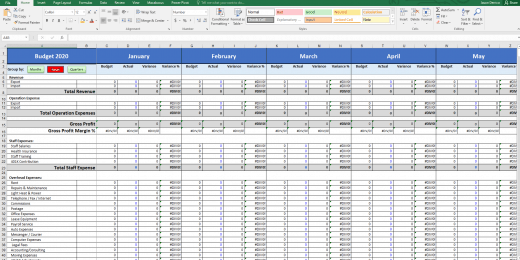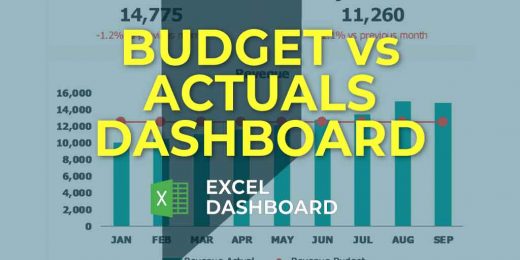The Ultimate Guide to Budget Vs Actual Variance

Budget vs actual variance analysis helps measure financial performance by comparing budgeted figures against actual results. It highlights discrepancies to aid managerial decision-making and financial control.
Understanding the nuances of budget vs actual variance is essential for any business looking to maintain financial health and strategic direction. This guide delves into the importance of tracking these variances and the insights they can provide. By analyzing where and why deviations occur, companies can adjust their budgeting processes and operational strategies to better align with their financial goals.
This ensures resources are allocated efficiently and that organizations stay on course to achieve their objectives. Effective variance analysis can be a powerful tool for businesses to remain competitive and responsive to market changes.
Budget Vs Actual Variance: Unveiling The Concept
No matter the size or type of a business, understanding where money goes is crucial. Managers and teams often set financial goals and make plans to hit these targets. This is where the concept of Budget Vs Actual Variance steps in. It’s a compass that guides financial navigation, pointing out if the business is on course or veering off track. It provides insightful data on business performance and paves the way for informed decision-making.
The Essence Of Budgeting
Setting budgets is like drawing a financial map for the journey ahead. A well-planned budget outlines expected income, expenses, and ultimately profit. More crucially, it creates a benchmark against which the company’s actual financial performance is measured. Good budgeting can steer companies towards success, prosperity, and stability.
- Identifying financial goals
- Allocating resources efficiently
- Anticipating future needs and expenses
- Monitoring cash flow
- Prioritizing investments
Actuals: The Mirror Of Reality
Tracking actuals reflects a company’s financial dealings in real-time. These figures represent real income and expenses, comparing them to the forecasted budget. This comparison often leads to variance. A variance is the difference between what was planned (budget) and what happened (actual). It can be a surplus or a deficit.
| Budget | Actual | Variance |
|---|---|---|
| $10,000 | $9,000 | -$1,000 |
| $5,000 | $6,000 | $1,000 |
A negative variance shows expenses were more than expected, or income was less than planned. A positive variance indicates expenses were less, or income was higher than expected. Both types offer opportunities for strategic adjustments in finance management.
The Significance Of Variance Analysis
Variance analysis is a cornerstone of budget management. It compares your expected financial results, or ‘budget’, to the actual numbers. This process highlights where you spent more or less money than planned. Recognizing these differences is crucial. It helps you understand your financial health.
Guiding Financial Decisions
Good decisions come from good data. Variance analysis gives you that data. It lets you see spending habits. This can help you solve problems. Or you can stay the course if things look right. Key decisions need this backup. It tells you to invest more or pull back funds.
Identifying Operational Efficiency
Not just about money, variance analysis also looks at operations. It answers questions like, “Are we doing things well?” It points out strong and weak areas. This guides you to improve or change.
- Better processes lead to savings.
- Weak spots show where to focus.
By measuring performance, you keep your business on the right track. It helps set future goals. And it aligns spending with those goals.
Setting Up For Success: Preparing Your Budget
Embarking on the journey of financial planning begins with a cornerstone: budget preparation. A robust budget sets a blueprint for the financial health and goals of any enterprise. It’s the compass that guides decision-making and evaluates performance. But what makes a budget effective?
Key Components Of An Effective Budget
An effective budget isn’t a mere list of numbers. It includes several key components that ensure it can serve its purpose:
- Income Estimates: Start with realistic projections of cash inflows.
- Expense Forecasts: Consider both fixed and variable costs.
- Financial Goals: Outline clear, achievable objectives.
- Flexibility: Make room for unexpected changes.
- Monitoring: Set up a system to regularly review financial activity.
Forecasting Techniques
Forecasting is a pivotal tool in budgeting that involves predicting financial trends. Different techniques offer varying levels of insight:
| Technique | Benefit | Use Case |
|---|---|---|
| Qualitative | Insight from expert judgement | New markets |
| Time Series Analysis | Uses historical data patterns | Stable industries |
| Causal Models | Factors in cause-effect relationships | Response to market changes |
| Econometric | Integrates economic theory | Macroeconomic forecasting |
By incorporating these forecasting techniques, budgets can predict future financial scenarios with higher accuracy. This leads to better-informed strategies and can drive a business towards success.
Recording And Tracking Actual Performance
Grasping the concept of ‘Recording and Tracking Actual Performance’ stands as a cornerstone in mastering budget vs. actual variance analysis. Engaging with this facet can shed light on financial health and guide better decisions.
Tools For Accurate Record-keeping
Immediate access to precise data emerges as non-negotiable for staying on top of finances. Several tools exist to make this process seamless and error-free. Let’s explore some popular choices:
- Spreadsheets:
ExcelandGoogle Sheetsoffer flexibility for custom reports. - Accounting Software: QuickBooks and Xero provide comprehensive solutions.
- Dashboard Tools: Tableau and PowerBI visualize data for quick insights.
Best Practices In Performance Tracking
Tracking goes beyond tools; adopting best practices ensures successful performance monitoring:
- Consistency: Maintain regular recording intervals.
- Accuracy: Double-check figures for errors.
- Comparative Analysis: Contrast actuals against budgets often.
| Task | Frequency | Tool |
|---|---|---|
| Update Ledgers | Daily | Accounting Software |
| Review Budget Variances | Weekly | Spreadsheets |
| Generate Reports | Monthly | Dashboard Tools |
Deciphering Variance: Favorable Vs Unfavorable
Understanding the differences between favorable and unfavorable variances is key in budget analysis. Such knowledge allows businesses to make informed decisions.
Interpreting Positive Variances
An actual result better than the budget is a positive variance. It’s a sign of efficiency. Below are ways to interpret these variances:
- Revenue streams exceed forecasts, showing strong performance.
- Costs remain lower than budgeted, indicating cost-saving success.
- Investment returns surpass expectations, reflecting savvy decisions.
Dealing With Negative Variances
Negative variances point to areas needing attention. They aren’t a red flag just yet, but require action. Here’s how to tackle them:
- Analyze the root cause to understand the discrepancy fully.
- Adjust processes if costs run higher or sales fall short.
- Plan corrective steps to get back on track swiftly.
Root Cause Analysis Of Variances
Root Cause Analysis of Variances is a critical process in financial management. Identifying reasons behind deviations helps businesses make informed decisions. Accurate analysis reveals areas needing attention and guides strategic planning.
Market Influences
Market factors can sway budgets significantly. Uncovering discrepancies means examining market dynamics closely. Key points to consider include:
- Commodity prices: Fluctuations impact cost of goods sold.
- Consumer trends: Shifts in preferences may affect sales volume.
- Competitive actions: Rivals’ pricing or strategy changes alter market conditions.
- Regulatory changes: New laws can increase operational costs unexpectedly.
Internal Factors
Investigating internal influences is just as vital. In-house variables that could impact budget variances include:
| Factor | Description |
|---|---|
| Efficiency | Higher or lower productivity levels than projected. |
| Operational changes | Alterations in process or equipment impacting costs. |
| Workforce | Changes in labor cost due to turnover or overtime. |
| Management | Decision-making that deviates from the budget plan. |
Understanding these elements aids in pinpointing corrective actions. Identifying patterns enables finer control over financial outcomes.
Bridging The Gap: Taking Corrective Actions
Discovering a variance between your budget forecasts and actual figures can stir up concern. Yet, it’s an opportunity for your business to tighten. Adopting effective strategies at this point is critical. These strategies help realign financial pathways. They guide your business back towards its original objectives.
Adjustments To The Budget Plan
Adjusting your budget is a step towards financial control. It’s vital when actual spending or revenue deviates from the plan.
- Review every budget category. Look for discrepancies.
- Identify specific areas with significant variances.
- Analyze the reasons behind the deviations.
- Update budget lines to reflect realistic expectations.
Regular comparisons of budget versus actuals help maintain financial health. Reworking the budget should always base on fresh insights.
Operational Strategies For Mitigation
Operations often bear the brunt of budget variances. Effective strategies can mitigate their impact. Here’s where to focus:
| Strategy | Action | Goal |
|---|---|---|
| Cost Control | Trim unnecessary expenses. | Reduce outflows, maintain quality. |
| Revenue Management | Boost income-generating activities. | Increase inflows. |
| Resource Allocation | Direct resources to high-performing areas. | Optimize use for better results. |
Applying these strategies can minimize negative impacts. It ensures that operations continue running smoothly. It steers the company back to its financial targets.
The Role Of Technology In Variance Management
Managing a budget effectively is crucial for any business’s success. Technology plays a critical role in managing variances between budget forecasts and actual financial performance. Tools and software designed specifically for variance analysis can transform financial management. They provide clear insights and enable agile responses to financial discrepancies.
Software Solutions For Variance Analysis
Diverse software solutions exist for meticulous variance analysis. These solutions simplify complex data crunching. They offer visual representations of variances. With software, managers can pinpoint discrepancies with a few clicks. Let’s look at the features of these technological tools.
- Real-time analysis: Instantly compare budgeted figures against actual results.
- User-friendly dashboards: Access intuitive interfaces for easy data interpretation.
- Customizable reports: Tailor reporting formats to meet specific business needs.
- Alert systems: Receive notifications for significant variances to act promptly.
Automating The Budget Vs Actual Process
Automation simplifies budgeting and analysis.
Automated systems integrate financial data sources. They streamline the comparison process. They save time and reduce errors. They allow finance teams to focus on analysis rather than data entry. By automating, organizations ensure:
- Consistency in data handling
- Accuracy in numbers
- Efficiency in processes
Implementing automation tools in variance management supports effective financial decision-making. They provide a clear pathway to understanding where a business stands financially and where it should head.
Case Studies: Real-world Variance Resolutions
Welcome to the insightful exploration of ‘Case Studies: Real-World Variance Resolutions‘. Businesses often face the challenge of their actual numbers not matching their budgeted plans. The reasons for these variances can unveil key insights into financial performance and management acumen. Let’s dive into real-world examples to learn how companies adapt to budget variances successfully or learn from mishaps.
Successful Budgetary Adjustments
Real-world companies often find innovative ways to address budget variances. A tech startup, for example, noticed a significant overspend on marketing. By analyzing trends, they shifted funds from less effective campaigns to those with higher ROI. This table summarizes the corrective steps they took:
| Quarter | Initial Overspend ($) | Action Taken | New Variance ($) |
|---|---|---|---|
| Q1 | 20,000 | Reduce traditional ad spend | 5,000 |
| Q2 | 15,000 | Invest in digital marketing | 3,000 |
These budgetary adjustments ensured finances were used effectively. The company stayed agile, making real-time shifts to optimize performance.
Learning From Variance Mishandling
Not all companies react well to budget variations. Consider a retail chain that faced a significant variance due to unplanned logistical costs. They chose to ignore these signals, resulting in compounded errors over time. Below is a bulleted list capturing the consequence of their inaction:
- Q3 losses doubled due to continued negligence.
- Investor confidence plummeted.
- Required drastic cost cuts in the following year.
This example serves as a learning opportunity. Ignoring budget variances can lead to greater issues. Quick recognition and analysis are crucial to financial stability.
Continuous Improvement: Adapting To Variance
Achieving financial goals requires a keen understanding of budget versus actual variances. Continuous improvement in adapting to variance becomes a key factor for success. In this ever-changing economic landscape, organizations need to develop a proactive stance. This means not only identifying these variances but also responding effectively to them. Let’s explore how creating a flexible budgeting framework and fostering a culture of financial responsibility can contribute to this agility.
Building A Flexible Budgeting Framework
A flexible budgeting framework is essential for addressing unexpected changes. It allows for adjustments to be made as actual figures come in. Such a framework could include:
- Variable costs: Aligning these costs with revenue fluctuations.
- Scenario analysis: Planning for different outcomes to quickly adapt to changes.
- Rolling forecasts: Extending beyond the fiscal year to adjust to trends.
Organizations could implement software tools to track and report these variances in real-time. Data-led insights will drive sound financial decisions tailored to current needs.
Fostering A Culture Of Financial Responsibility
To effectively manage budget variances, cultivating a culture that emphasizes financial responsibility throughout the organization is crucial. This includes:
- Training staff to understand financial impact and their role in it.
- Promoting transparent communication regarding financial performance.
- Encouraging teams to contribute ideas for cost-saving strategies.
Recognition programs for individuals and teams who perform well in managing their budgets can further reinforce this culture. Ultimately, this shared financial accountability leads to more accurate budgeting and better adaptation to variance.
Frequently Asked Questions
How Do You Explain Variance Between Budget And Actual?
Variance between budget and actual reflects the difference in planned versus realised financial performance. Causes include unexpected expenses, revenue shortfalls, or changes in market conditions. Identifying these variances aids in financial analysis and future budgeting strategies.
What Is The Best Chart For Budget Vs Actual?
The best chart for comparing budget vs actual figures is typically a variance chart, which clearly shows the differences between projected and real numbers.
How To Monitor Variance Between Actual And Budgeted Performance?
To monitor variance between actual and budgeted performance, regularly compare financial reports, track key performance indicators, and utilize budgeting software for real-time analysis. Conduct periodic reviews and adjust strategies as necessary.
How Do You Review Budget Vs Actual?
Reviewing budget vs actual involves comparing planned financial estimates with actual expenditure. Analyze variances, identify trends and adjust future budgets accordingly. Regularly assess to ensure financial alignment with business objectives.
Conclusion
Understanding budget versus actual variance is crucial for financial health. It empowers businesses and individuals to react strategically to financial data. By mastering the concepts and techniques outlined in this guide, you’re set to make informed decisions. Embrace these insights for sustained fiscal success, ensuring your budgeting efforts truly pay off.



















































